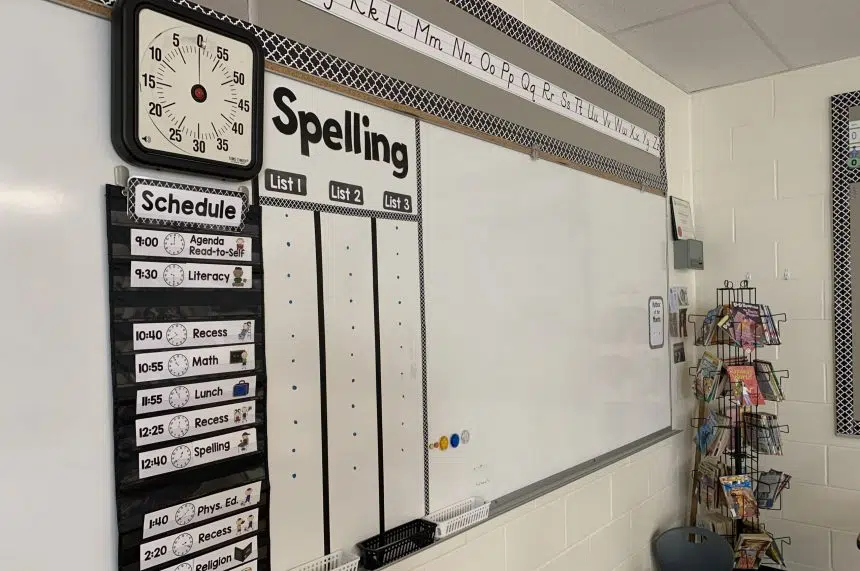The hoarding of toilet paper may be over, but be prepared for it to now start with hand sanitizer.
It is going to be one of the major items kids and staff will need when they return to classrooms in September.
It is just one of the major requirements of guidelines put forward by the provincial government and its education response planning team.
Education Minister Gord Wyant said while there are standards they expect schools to follow, the guidelines are meant to be flexible. He explained they could change between now and Sept. 1 and even during the school year depending on the pandemic situation.
“They certainly aren’t carved in stone. We want to be as flexible as possible to make sure that we’re providing the best educational opportunities for our kids within the parameters of the guidelines that are in place.”
Schools will be able to configure some things to their buildings, like signage and how students enter.
If the pandemic gets worse, guidelines may be tightened, but provincial chief medical health officer Dr. Saqib Shahab indicated schools likely won’t be closed again.
“Even if there are two or three children in the class or there’s an outbreak within the school, I don’t think that necessarily means the school needs to shut down again. I think it just means there needs to be enhanced attention to hand washing, maybe other measures just to slow transmission down.”
He pointed out that many daycares have been open through the lock down and there haven’t been any issues there.
But masks and personal protective gear are not recommended.
Instead, it includes that schools look at modifying procedures for entering the building to support physical distancing. That could mean strategies like staggered entry into classes and schools, separate group entrances, limiting pickups and drop offs to one parent/guardian.
It is also suggested that recess/snack and lunch and class transition times be staggered.
The guidelines also include making modifications to all shared spaces, including boot rooms, hallways, waiting areas, etc.
School divisions will also need to provide signage to promote physical distancing, hand-washing and perhaps marking to limit what is described as cross-exposure.
“As we return to normal activities within our daily lives, we want to ensure that our school communities have time to prepare for new health and safety requirements,” Wyant said. “These guidelines reinforce minimizing physical contact while maintaining a school atmosphere that’s as normal and comfortable as possible.”
Many of the new guidelines will cost extra whether for man hours or equipment, but Wyant said the ministry isn’t allocating extra money just yet.
“We want to make sure that we have that conversation in the context of what those costs might be relative to how much money’s been saved by those school divisions over the last number of months.”
Wyant said they’ll be working with school divisions and the SSBA to figure out the cost of new measures.
Young children
The guidelines acknowledge that for younger children, maintaining physical distance is less practical and the focus should be on minimizing physical contact instead.
It states that staff, parents and students must encourage and practice preventative measures, such as limiting physical contact, throughout the school day (i.e. during instruction, recess, nutrition programs, extra-curricular) and avoiding close greetings (i.e. hugs, handshakes).
“Help younger children learn about physical distancing and less physical contact by creating games that include basic principles such as ‘two-arm lengths apart’ and avoid close greetings like hugs or handshakes. Encourage physically distant greetings such as ‘air fives’ and waves”, the guidelines state.
Transportation
School busing will go ahead as planned but the guidelines recommend that students should be assigned seats and a record of this seating plan should be kept in order to assist with contact tracing in the case of a student being confirmed with a case of COVID-19.
Students who live in the same household should be seated together and the school bus companies may want to consider partitions around the driver.
The guidelines state school busing should not be used for field trips and where possible parents should be asked to transport their own children.
The buses have to be sanitized between each use.
COVID-19
Checking temperatures or screening questions are not recommended. But if a child becomes ill at school or develops symptoms similar to COVID-19 the guidelines are quite strict as to how staff need to handle the situation.
Schools should identify an appropriate isolation area for anyone with COVID-19 symptoms who are not able to immediately leave the facility. If a student develops symptoms at school or upon arrival at school, the student should be isolated from other students and the parent or guardian should be notified to pick up the student immediately.
If a separate room is not available, the student needs to be kept at least two metres away from other students and staff and the student requires close contact and care, staff must wear a procedural/surgical mask and eye protection during all interactions with the sick child, and should try to avoid contact with the student’s respiratory secretions.
Once the child has left the building the whole area must be cleaned and sanitized.
Other guidelines
Students with additional needs may require updated assessments and revised individual goals.
Plans for extra-curricular activities and other gatherings will be developed in consultation with the Chief Medical Health Officer once the group/gathering capacity limits for fall 2020 are known.
The school year is set to begin in most divisions on Sept. 1.


